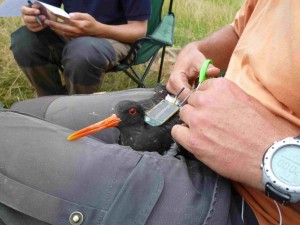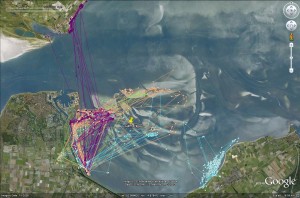
Given the vast area of the Wadden Sea area and the high mobility of the shorebirds that live here, it is very hard to predict how foraging birds distribute themselves during low tide. Nevertheless it is crucial to know in which areas birds forage most intensively and most often, especially in relation to human activities like shellfish fishery, recreational disturbance, military training exercises and soil subsidence due to gas extraction.
In this project we try to reveal how fine-scale patterns in food (cockle and mussle beds), sediment and immersion time determine the spatial distribution of foraging Oystercatchers (Haematopus ostralegus). The Oystercatcher is one of the most abundant shorebirds in the Wadden Sea, however in recent years their numbers have declined rapidly. GPS tracking is used to identify those parts of the tidal flats that are used most intensively for foraging. Year-round observations of individuals can be subsequently used to build and validate spatially explicit foraging models describing the entire population.
By integrating a population foraging model and tracking data of individual birds we hope to identify which habitats within the Wadden Sea are most crucial to Oystercatcher survival, especially during the harsh winter season when birds have to forage intensively to meet their daily energy budget. The foraging patterns of GPS-tagged birds are complemented with continuous (day and night-time) observations of Oystercatchers by camera, which has been stationed on a central tidal flat within the Balgzand located in the very west of the Dutch Wadden Sea. Camera-observations are used to observe how (part of the) Balgzand population of Oystercatchers exploits a single site, in relation to the fine-scale structures in sediment, organic structures and food, and provides a site-specific dataset for testing Oystercatcher foraging models.

Contact persons, funders and participants
Adriaan Dokter, IBED-UvA, a.m.dokter@uva.nl
Bruno Ens, SOVON Dutch Centre for Field Ornithology bruno.ens@sovon.nl
University of Amsterdam Institute for Biodiversity and Ecosystem Dynamics / Instituut voor Biodiversiteit en Ecosysteem Dynamica (IBED) w.bouten@uva.nl
Dutch Centre for Field Ornithology (SOVON)
Imares Wageningen
